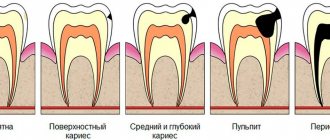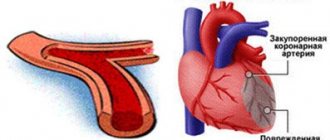Ultrasound diagnostics is one of the safest and most effective ways to detect various diseases of internal organs. This technique is used in various fields of medicine, including assessment of the condition and possible pathologies of blood vessels. In this case, Doppler ultrasound or ultrasound is performed, which is used to examine the neck and head. Early diagnosis allows you to choose gentle and effective treatment methods and prevent the development of complications. First you need to understand what an ultrasound scan of the vessels of the head and neck shows, why this method is effective in diagnosing many diseases.
The Doppler ultrasound effect is based on the ability of ultrasound waves to be reflected from blood cells. As a result, electronic impulses appear that appear on the device screen in the form of images of veins and arteries with blood flow.
This ultrasound examination allows you to assess the condition of the large arteries that supply the brain, carotid and vertebral arteries, determine the intensity of blood flow, and also identify traces of obstruction.
How is Dopplerography performed?
This examination is carried out in the presence of certain symptoms. Preliminary preparation is necessary so that the results of the ultrasound examination give an accurate picture of the patient’s condition.
There are two types of procedure:
- Transcranial. The sensor is installed on the skull bones in those places where they are thinnest. The procedure gives an accurate picture of the vessels located directly in the brain.
- Extracranial. The technique is used to examine large vessels passing through the neck (carotid arteries, jugular veins, etc.). The sensor is located at each site separately.
What ultrasound methods exist?
1. Doppler ultrasound is standardly included in ultrasound examination of the heart (Echocardiography, echocardiography, echocardiography with Doppler are synonyms). Allows you to assess the condition of the heart valves and blood flow in the cavities and large vessels.
2. Doppler ultrasound of the branches of the aortic arch (synonyms: Doppler ultrasound of the neck vessels, Doppler ultrasound of the brachiocephalic vessels) - study of the main arterial and venous vessels involved in the blood supply to the neck, head and brain. This is one of the most frequently performed studies and allows us to identify impaired patency of the carotid and vertebral arteries due to atherosclerosis, vascular abnormalities and spinal pathology. As an additional method, the so-called TCD (transcranial Doppler sonography) can be performed, which allows you to directly assess the blood supply to the brain.
3. Doppler ultrasound of the arteries of the upper or lower extremities . It is carried out in cases of impaired patency of the peripheral arterial bed (atherosclerosis, obliterating endarteritis, diabetes mellitus).
4. Doppler ultrasound of the veins of the upper or lower extremities . It is carried out in case of blood clots in peripheral veins, as well as in case of varicose veins to assess the consistency of venous valves and determine the patency of the veins.
Indications for the procedure
Doppler sonography is indicated in the following cases:
- Problems with coordination and other symptoms indicating a malnutrition of the brain (the patient is dizzy, has tinnitus, etc.).
- Unstable heart rhythm.
- Hypertonic disease.
- Transient ischemic attacks.
- IOP.
- Previous stroke or heart attack.
- There are suspicions of atherosclerosis.
- Diabetes.
- Fatigue quickly for no apparent reason.
- Cervical osteochondrosis.
This procedure is also indicated if heart surgery is to be performed, if there are pulsating formations in the neck, or if thrombosis is suspected. In children, it is performed in case of serious postural problems and delayed development of the child.
Indications for Dopplerography of head vessels:
- chronic and acute cerebral circulatory disorders or suspicion of them;
- the patient belongs to groups at increased risk of atherosclerosis and other pathological vascular conditions;
- absence of pulse and blood pressure in the arteries of the arms against the background of intense deterioration of visual acuity;
- abnormal changes in the cervical spine due to diseases or congenital anomalies, which can lead to compression of the vertebral artery;
- suffered traumatic brain injuries, as a result of which the vessels were damaged;
- vascular damage due to toxic effects or surgery.
Are there any contraindications?
Ultrasound waves are absolutely safe for humans, so there are no special contraindications to this type of ultrasound. The only exception is a violation of the integrity of the skin. The procedure involves contact of sensors with the head or neck, so the examination is postponed until the wound heals.
However, there are a number of special cases that make duplex examination of blood vessels difficult:
- cardiac arrhythmia, which changes the speed of blood circulation through healthy arteries and veins;
- the area under study is hidden under bone tissue;
- slow blood flow in the patient.
These are not contraindications, but in this case changes in the location of the sensors are required. It will be necessary to navigate non-standard conditions, which requires professionalism on the part of the doctor.
Features of ultrasound examination
As a rule, Doppler sonography is planned in advance, but it can be performed urgently. The procedure itself is painless, so patients tolerate it calmly.
The examination is carried out according to the following scheme:
- The patient lies on his back. The head should be relaxed (a flat pillow is placed under it).
- You need to remain calm, breathe evenly and, if possible, not move.
- A special gel is applied to the area under study to prevent the penetration of air between the skin and the sensor.
- The movement of the sensors is controlled by a specialist. As a result, an image of the vessels appears on the monitor screen.
The study lasts no more than 1 hour. During the study, the doctor may ask the patient to do some action: turn his head, squeeze a vein in a certain place, breathe less often, etc.
Dopplerography of extracranial vessels begins with examination of the right lower segment of the carotid artery. The sensor is then moved up the neck. Next, the color mode is activated, which makes it possible to identify a number of pathologies: deformations of the walls of blood vessels, impaired blood flow in certain areas, etc.
Interpretation of the results of ultrasound examination of the neck and head
In the process of studying the results obtained, the doctor compares them with normal indicators in a number of categories:
- lumen diameter and vessel wall thickness;
- the nature of blood flow and its quality;
- indications of blood flow in the arteries of the same name, synchronicity of the process;
- Vd, Vs and TAMX indicators (diastolic, peak systolic and maximum blood flow velocity, respectively);
- RI and PI (resistance index, pulsatility index, respectively).
We invite you to familiarize yourself with the average indicators of blood flow in certain arteries of the head, presented in our table below:
| Artery name | General sleepiness | Vertebrate | External carotid | Internal sleepy |
| D lumen | from 4.2 to 6.9 mm | from 2 to 4.4 mm | from 3 to 6 mm | from 3 to 6.3 mm |
| Vs | from 50 to 104 cm/s | from 20 to 61 cm/s | from 37 to 105 cm/s | from 32 to 100 cm/s |
| Vd | from 9 to 36 cm/s | from 6 to 27 cm/s | from 6 to 27 cm/s | from 9 to 35 cm/s |
| TAMX | from 15 to 51 cm/s | from 6 to 21 cm/s | from 5 to 26 cm/s | from 9 to 35 cm/s |
| R.I. | from 0.6 to 0.8 | from 0.6 to 0.8 | from 0.6 to 0.9 | from 0.6 to 0.8 |
| P.I. | from 1.1 to 3.5 | from 0.6 to 3 | from 1.1 to 3.9 | from 0.8 to 2.8 |
Correct decoding allows us to identify a number of pathological conditions of the patient’s vascular system.
What can she show?
Duplex scanning allows you to determine areas of narrowing of the lumen of blood vessels, the direction of blood flow, its speed, as well as the condition of the vascular walls. This study can show the location of cholesterol plaques and the presence of blood clots, which is very important when diagnosing atherosclerosis.
A decrease in the elasticity of the walls of the arteries, as well as their thickening, indicate that the patient has hypertension (high blood pressure). If a change in blood flow is diagnosed, this indicates the presence of obstacles. For example, an aneurysm is a sac-like protrusion of a vessel.
Doppler ultrasound: what is it?
The abbreviation “UZDG” stands for “ultrasound triplex Dopplerography”.
This is one of the ultrasound diagnostic techniques based on the ability of moving blood cells to reflect acoustic ultrasound waves. Thanks to it, it is possible to determine the parameters of cerebral circulation and identify those areas where it is absent or its speed changes. The procedure is carried out in real time and is reliable. In the process, the ultrasound scanner sensor emits waves, and then picks up their modified reflections - and after they are converted, a corresponding image is displayed on the scanner screen.
What pathologies can be diagnosed?
Doppler ultrasound has certain limitations in diagnosing diseases. For example, she will not be able to study small veins - for this she needs to perform angiography. But there are a number of pathologies that can be identified:
- Atherosclerosis. By examining the head and neck using ultrasound, it is most often possible to diagnose atherosclerotic disorders. This condition is indicated by echogenicity, the presence of plaques, and thickening of the vascular walls. Moreover, if the lumen of the artery narrows by more than 20%, then the patient is diagnosed with “stenosis.”
- Thrombosis. Thrombosis is characterized by blocking of the arterial lumen by a blood clot. On Doppler ultrasound, inflammation of the vessel wall with a homogeneous formation inside is clearly visible.
- Compression of blood vessels. The examination allows you to see areas where blood flow is impaired due to the impact of swollen tissue on the channels. This allows you to diagnose cervical osteochondrosis and identify problems with blood circulation after injuries.
In addition, these ultrasound examinations can detect a number of other diseases, including vasculitis, post-traumatic dissections of the arterial walls and other pathologies.
Doppler ultrasound is a safe diagnostic method that can be performed in any case if there is a medical need for it. Timely implementation of the procedure allows you to identify the disease at an early stage of its development.
Examination of infants
Many parents are afraid of undergoing such tests in newborn age. At the same time, the examination is considered absolutely safe, so it can be carried out from the very first days of the baby’s life.
The first heart test for a child is carried out within the walls of the maternity hospital. The procedure allows you to exclude congenital organ defects. At the age of one month, the mandatory examination is repeated. The following are carried out annually if no pathologies are detected.
Parents need to know the characteristics of the heart muscle of infants and have an idea about detecting alarming symptoms, for example, listening to noises.
The heart of a newborn is quite large. Muscle accounts for 0.8 percent of the infant's body weight. While for an adult it is only 0.4 percent.
Are you planning to have an ultrasound? The price of the examination depends on the range of services.
With age, the mass increases: by eight months it doubles, by three years it triples, by six it increases 11 times. The pediatric cardiovascular system differs in physiology and anatomy from that of adults and requires careful monitoring at each stage of development.
It is important to do a screening examination for infants at 1-1.5 months.
It includes studying:
- brain structures through the fontanelle (neurosonography),
- abdominal organs, kidneys and pelvis,
- hip joints.
The test helps to detect deviations in the child’s development in time and begin therapeutic and preventive actions. The sooner doctors begin treatment, the better the effect of the therapy, until complete recovery.
Why is it important to do an ultrasound of the heart in a teenager?
Puberty is a period of active growth during which deviations in the development of the cardiovascular system can be observed. Therefore, the child must be monitored constantly.
Using ultrasound, a specialist determines whether the oval window has closed. This is a hole in the interatrial septum. Normally, it should close after birth, but there are cases when the septum remains open for 10-12 years. Such tests are especially important for those teenagers who lead an active lifestyle with increased physical activity: they attend sports clubs and train.
Physical overload increases the risk of arrhythmias and an increase in the size of the oval window. Therefore, any physical and mental stress requires consultation with a specialist.
The pediatric cardiologist begins the appointment with a general examination and issues a conclusion based on the results.
Research before the army
Enrolling in military service is a stressful situation in which a young man is faced with new living conditions and heavy physical exertion. All together have a negative effect on health.
It is important to undergo examination by a cardiologist. If a specialist misses a serious illness, then physical activity in the army can lead to complications. The pre-conscript needs to undergo the necessary tests to rule out congenital defects.










